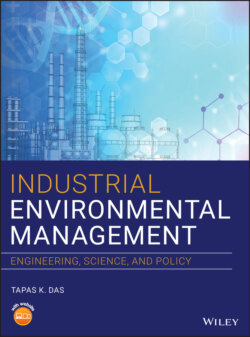Читать книгу Industrial Environmental Management - Tapas K. Das - Страница 126
2.13.3 General 2.13.3.1 Environment (Protection) Act, 1986 (USEPA)
ОглавлениеThis Act is an umbrella legislation designed to provide a framework for the coordination of central and state authorities established under the Water (Prevention and Control) Act, 1974 and Air (Prevention and Control) Act, 1981. Under this Act, the central government is empowered to take measures necessary to protect and improve the quality of the environment by setting standards for emissions and discharges, regulating the location of industries, management of hazardous wastes, and protection of public health and welfare.
From time to time the central government issues notifications under the USEPA for the protection of ecologically sensitive areas or issues guidelines for matters under the USEPA.
The following are some notifications issued under this Act:
Doon Valley Notification (1989), which prohibits the setting up of an industry in which the daily consumption of coal/fuel is more than 24 million T/day in the Doon Valley.
Coastal Regulation Zone Notification (1991), which regulates activities along coastal stretches. As per this notification, dumping ash or any other waste in the CRZ is prohibited. The thermal power plants (only foreshore facilities for transport of raw materials, facilities for intake of cooling water and outfall for discharge of treated waste water/cooling water) require clearance from the MOEF.
Dhanu Taluka Notification (1991), under which the district of Dhanu Taluka has been declared an ecologically fragile region and setting up power plants in its vicinity is prohibited.
Revdanda Creek Notification (1989), which prohibits setting up industries in the belt around the Revdanda Creek as per the rules laid down in the notification.
The Environmental Impact Assessment of Development Projects Notification (1994 and as amended in 1997). As per this notification:All projects listed under Schedule I require environmental clearance from the MOEF.Projects under the delicensed category of the New Industrial Policy also require clearance from the MOEF.All developmental projects whether or not under the Schedule I, if located in fragile regions must obtain MOEF clearance.Industrial projects with investments above ₹500 million must obtain MOEF clearance and are further required to obtain a LOI (Letter Of Intent) from the Ministry of Industry, and an NOC (No Objection Certificate) from the SPCB and the State Forest Department if the location involves forestland. Once the NOC is obtained, the LOI is converted into an industrial license by the state authority.The notification also stipulated procedural requirements for the establishment and operation of new power plants. As per this notification, two‐stage clearance for site‐specific projects such as pithead thermal power plants and valley projects is required. Site clearance is given in the first stage and final environmental clearance in the second. A public hearing has been made mandatory for projects covered by this notification. This is an important step in providing transparency and a greater role to local communities.
Ash Content Notification (1997), required the use of beneficiated coal with ash content not exceeding 34% with effect from June 2001. This applies to all thermal plants located beyond 1000 km from the pithead and any thermal plant located in an urban area or sensitive area irrespective of the distance from the pithead except any pithead power plant.
Taj Trapezium Notification (1998), provided that no power plant could be set up within the geographical limit of the Taj Trapezium assigned by the Taj Trapezium Zone Pollution (Prevention and Control) Authority.
Disposal of Fly Ash Notification (1999), the main objective of which is to conserve the topsoil, protect the environment, and prevent the dumping and disposal of fly ash discharged from lignite‐based power plants. The salient feature of this notification is that no person within a radius of 50 km from a coal‐or lignite‐based power plant shall manufacture clay bricks or tiles without mixing at least 25% of ash with soil on a weight‐to‐weight basis. For the thermal power plants the utilization of the fly ash would be as follows:Every coal‐or lignite‐based power plant shall make available ash for at least ten years from the date of publication of the above notification without any payment or any other consideration, for the purpose of manufacturing ash‐based products such as cement, concrete blocks, bricks, panels, or any other material or for construction of roads, embankments, dams, dykes, or for any other construction activity.Every coal‐ or lignite‐based thermal power plant commissioned subject to environmental clearance conditions stipulating the submission of an action plan for full utilization of fly ash shall, within a period of nine years from the publication of this notification, phase out the dumping and disposal of fly ash on land in accordance with the plan.
Rules for the Manufacture, Use, Import, Export and Storage of Hazardous Micro‐organisms/Genetically Engineered Organisms or Cell were introduced in 1989 with the view to protect the environment, nature, and health in connection with gene technology and micro‐organisms, under the Environmental Protection Act, 1986. In 1991, the government further decided to institute a national label scheme for environmentally friendly products called the “ECOMARK.” The scheme attempts to provide incentives to manufactures and importers to reduce adverse environmental impacts, reward genuine initiatives by companies, and improve the quality of the environment and sustainability of available resources. Besides the above attempts, notifications pertaining to Recycled Plastics Manufacture and Usage Rules, 1999 were also incorporated under the Environment (Protection) Act of 1986.
